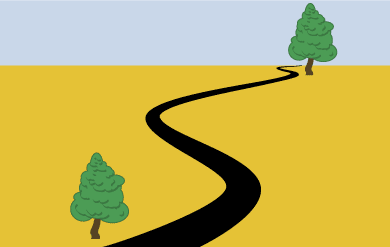Cards In This Set
| Front | Back |
|
What are depth cues, and what do depth cues help us determine?
|
Sources of information from the environment (external cues) or from within our body (internal cues) that help us perceive how far away an object is and where they are perceptually located
|
|
What information do they provide us with about 3D images?
And what are they categorised in? |
Provide us with information to transform 2D images into 3D reality
Monocular (one eye) Binocular (two) |
|
What are binocular depth cues important in?
|
Requires both eyes working together to determine the distance of relatively close objects
(if vision was only limited to one eye, this would be extremely difficult) |
|
What is retinal disparity?
|
Angled difference between the two retinal images of the object due to the 6-7 cm distance between our eyes.
(Each retina receives a slightly different visual image due to the angles of the views) -The images are compared, and the disparity between the two enables us judge the distance of an object from the viewer - greater disparity - the closer the brain interprets the object to the viewer. |
|
What is convergence? When is it mainly effective?
|
CROSS EYE
The simultaneous inward turning of both eyes to focus on a nearby object. Brain interprets the object to be closer as the tension of muscles required to turn eyes inward increases. This is because we try to maintain the image of the object we're focusing on the fovea (to provide a straight line from the fovea to the close object) Mainly effective when the object within our focus is 6-7 metres beyond this distance the lines of sight from our eyes to the object are virtually parallel and there is no need for our eyes to converge to maintain focus. |
|
What are monocular depth cues?
|
Requires the use of one eye to provide the brain with information about depth and distance
|
|
What is accommodation?
|
The automatic focusing of lens on an object
bulging (near objects) or flattening (distant objects) and also continuing focus on moving objects. Large close up objects would be normally too large to fit onto the retina, so the flexibility of the convex lens allows it to bulge to accommodate close or distant objects on the retina. The brain determines the depth and distance of an object by interpreting information about how much the lens bulges/flattens |
|
What is a linear perspective?
|
A pictorial cue
- the apparent meeting of parallel lines as they recede into the distance providing information about depth and distance. - The closer the lines appear to be merging, the further away the point is perceived - Objects located near that point will be perceived as being a greater distance from the viewer. |
|
What is interposition?
|
A Pictorial Cue
Overlapping occurring when one object partially obscures another. The partially obscured object is perceived as further away than the object that is obscuring it. |
|
What is texture gradient?
|
The gradual diminishing of detail that occurs in surfaces as they recede into the distance
Objects that are close up are seen in fine detail. -Our judgement about depth and distance is influenced by the extent to which we can detect fine detail. |
|
What is relative size?
|
The use of other, near by objects to judge the size in relation to them.
We have the tendency to visually perceive that object that produces the largest image on the retina as being closer. NOTE - objects perceived must be expected to be the same size. |
|
Height in the visual field?
|
 Refers to the location of objects in our visual field. Objects that are located closer to the horizon are perceived as being further away from the viewer. The tree that is closer to the horizon is perceived as being further away. The tree that is further away from the horizon is perceived as being closer to the viewer. |
|
What is a Visual Constancy?
|
The tendency to perceive a visual stimulus as remaining stable and unchanging despite any changes occurring to the image cast on the retina.
Such as changes to size, brightness, orientation and shape. |
|
Size constancy?
|
The automatic tendency to perceive an object as staying the same size despite any changes to the image on the retina.
|
|
What is Shape Constancy?
|
The automatic tendency to perceive an object as maintaining its shape despite any change in the shape of the object's image cast on the retina.
- becomes difficult at extreme angles. |



